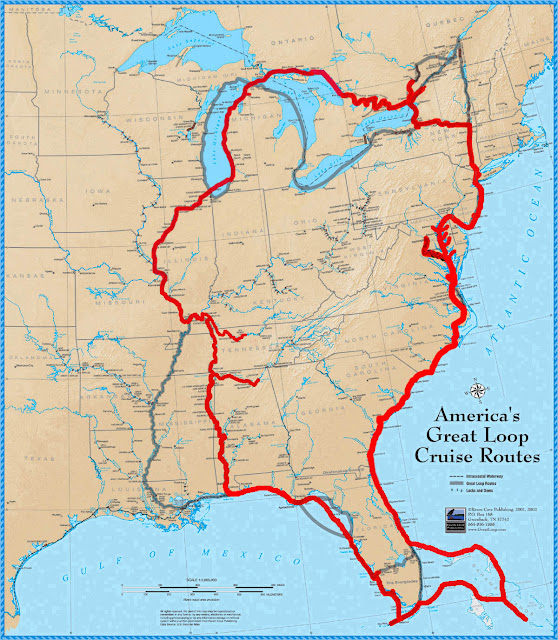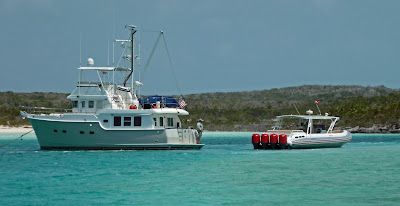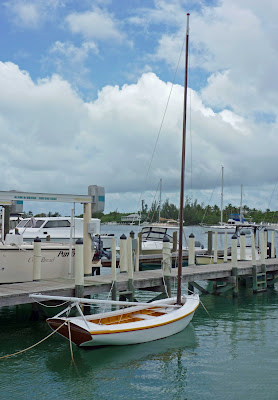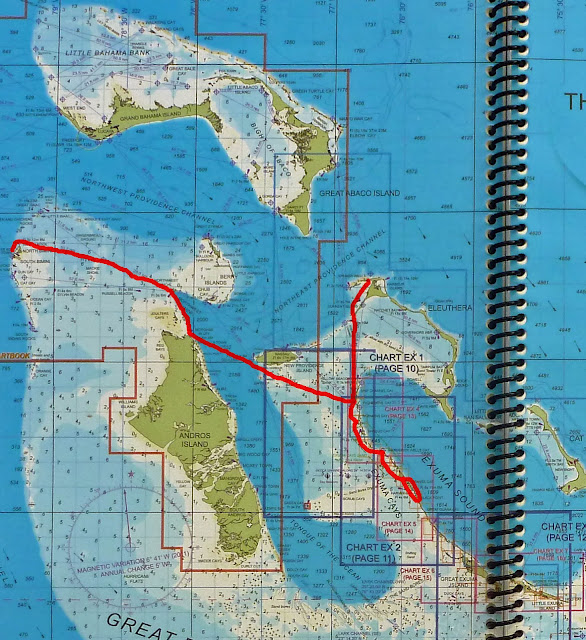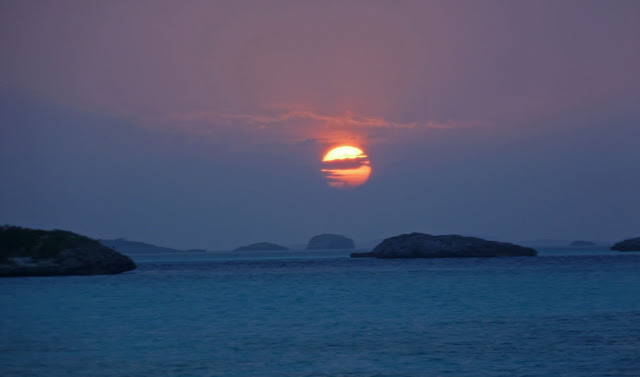Last Dance
Cruising on Last Dance
"The world is a book, and those who do not travel read only a page." St. Augustine, 354 - 430
“Twenty years from now you will be more disappointed by the things that you didn't do than by the ones you did do. So throw off the bowlines. Sail away from the safe harbor. Catch the trade winds in your sails. Explore. Dream. Discover.” Mark Twain, 1835 - 1910
"There is nothing -- absolutely nothing -- half so much worth doing as simply messing around in boats." The Wind in the Willows, 1908, Kenneth Grahame, 1859 - 1932
"I've never believed speed and ease are conductive to living fully, becoming aware, or deepening memory, a tripod of urges to stabilize and lend meaning to life." River Horse: a log book of a boat across America, 1999, William Least Heat-Moon,1939 -
The Great Loop -- The current adventure is a circumnavigation of the Eastern United States, cruising north up the east coast through New York into Canada, across the Great Lakes to Chicago, navigating multiple river systems south to Mobile, along the Gulf coast to the Florida Keys and back to St. Augustine. This trip by boat is commonly referred to as the Great Loop. Progress and current location are indicated by the red line on the map to the right. It was titled the Traceless Path in recognition of a German sailor we met in St. Augustine who published booklets of his travels with hand-drawn, detailed maps describing his travels across the water as the Traceless Path.
The Great Loop -- The current adventure is a circumnavigation of the Eastern United States, cruising north up the east coast through New York into Canada, across the Great Lakes to Chicago, navigating multiple river systems south to Mobile, along the Gulf coast to the Florida Keys and back to St. Augustine. This trip by boat is commonly referred to as the Great Loop. Progress and current location are indicated by the red line on the map to the right. It was titled the Traceless Path in recognition of a German sailor we met in St. Augustine who published booklets of his travels with hand-drawn, detailed maps describing his travels across the water as the Traceless Path.
Wednesday, December 23, 2015
Second Time Around
Realizing the weather-driven pace of completing the Great Loop in one year does not allow sufficient time to visit and enjoy all the many interesting places in eastern North America, the crew of Last Dance made the decision to continue the journey. Loop Two began in the fall/winter of 2012 with a cruise up the St. Johns River, then north on the east coast to Maine in 2013. The second Loop will require multiple years with Last Dance spending the winters in heated storage. To view the places visited on Loop Two, click the link below:
The image above is from the 2015 cruise to Maine, with Last Dance at anchor in Seal Bay, a very protected cove on the island of Vinalhaven in Penobscot Bay.
Friday, August 31, 2012
Loop Completion - Part 3 - Return to St. Augustine
500 Days
8000 miles
Countless Memories
The third completion point of the Great Loop was reached on July 6, 2012, at the point the continuous journey began on March 1, 2011. The adventure, circumnavigating eastern North America via waterways, took the Last Dance crew to many interesting places in the United States, Canada, and the Bahamas. From some of the largest cities to uninhabited islands, interesting and beautiful vistas were experienced. More importantly, many new friends were made in many different places. Thanks to all our old friends who followed us along this journey and to the many new friends developed along the way.
The Gold ALGCA burgee, signifying the completion of the Great Loop was taken to one of the most famous of St. Augustine landmarks, the Bridge of Lions, posed by the northern lion.
At the time of this posting, Last Dance is undergoing major maintenance in preparation for her next adventure, of which there are multiple options. One is to sell the boat and move onto the next dreamboat - larger of course. The second is to continue cruising on Last Dance, albeit at a slower pace. How can you travel at a slower pace than 7 mph? By traveling shorter days and staying longer at each location visited. The fall will find her traveling north until the cold weather dictates a turn to the south or someone decides to make Last Dance their cruising platform.
 |
| St. Augustine Bay |
Sunday, August 26, 2012
Bahama Islands - Miscellaneous Ramblings
Towing
Pearl, a13' Boston Whaler, trails Last Dance on her short painter (a line attached to a bow of a boat for towing or making fast). The deck of Last Dance is not large enough, nor is the lifting system stout enough, to carry a sizable dinghy aboard. In the Bahamas, a large dinghy makes a great diving platform and adequate fishing boat. So, towing a dinghy provides a great boating resource, though it adds complications and safety issues. Here, heading home to St. Augustine, leaving an anchorage in Ft. Pierce, FL.

Even large boats find needs for support boats too big to load aboard. Here, a sizable motor yacht tows a 21 foot center console fishing boat in the Exumas.
And some wish to have a tender that is even too large to tow. The 36' quadruple-engined RIB (rigid inflatable boat) accompanied a 100+ foot yacht. Here, it is backing to a 47' Nordhavn to pick up someone for a gathering on the mothership.
If you have numerous interests on the water, you can tow multiple boats. Here, off Elbow Cay in the Abacos, a cruiser tows an Abaco racing dinghy (the famous Abaco Rage), an off-shore fishing boat, and a flats boat.
There are no towing services, such as BoatUS or SeaTow, in the Bahamas. If you experience difficulties, you are on your own. Here, a 36' Krogen Manatee, which had a transmission fail, is towed by a generous guy, who was single-handing a 34' Marine Trader. It took 2 days to tow the boat to the nearest mechanic.
Inflatables
Boats with inflatable pontoons are the most popular type of dinghy accompanying cruisers in the Bahamas. The inflatable at right demonstrates why the crew of Last Dance tends to describe this type of boat as a "deflatable," although never in earshot of Rubber Ducky, which sits on the aft deck of Last Dance.
Big Boats
Megayachts travel in the Bahamas, particularly in the Exuma Islands. The large number of them testifies to the fact that the one percenters are doing well. Above, at Manjack Cay, two mega yachts are rafted side to side, with a string of water toys (other boats) on a line behind the boats.
Pay Up
The Exuma Cays Land and Sea Park is a 176 square mile park that is a no-take zone, creating waters filled with sea life for exploration. The park has very secure moorings in protected harbors, for which there is a daily charge. At the Cambridge Island moorings, cruisers are expected to place their payment in a box on a small island. The park rangers come to check on payments, and will make personal visits to boats whose crew have not made the trip to the small island. A member of the Royal Bahamian Defense Force, carrying an AK47, accompanies the ranger. The Last Dance crew always made the long trip to the box on the island.
Laid-Back, Easy-Going Pace
The only bank on Green Turtle Cay, in downtown New Plymouth, has hours that brings new meaning to the term "Bankers' Hours." The staff arrives on the morning ferry with a satchel of money and a guard, then returns to the mainland (as Big Abaco Island is called) on the early afternoon ferry - twice a week.

The library is open Monday through Friday, from 2:00 - 5:00 pm. The sign on the door denotes different days, but to be accurate, it would require making a new sign - not consistent with laidbackness.
Critters
One of the interesting aspects of cruising remote areas is the wildlife encountered. This Land Crab, ready to protect his turf, was in the woods on a very skinny peninsula at Powell Cay.
Only a few feet away, on the beach, this Ghost Crab stands still, believing he cannot be seen if he doesn't move. Although these two species of crabs share a small piece of the island, they would never interact as they inhabit different terrain.
A favorite in the underwater world is the Trigger Fish. When Jill talks to them, they will come close. This Trigger, just off the beach on Powell, came within one foot. They have not learned to enjoy being petted, but give Jill a little time.
 Reading List
Reading List
Wind from the Carolinas is historical fiction, written much in the style of James A. Michener, describing the lives of the people who fled the United States after the Revolutionary War. It is centered in the Exumas, following a family from the Carolinas who settle on Grand Exuma, attempting to recreate their plantation life. This book is an interesting-to-read account of the Loyalists and British adventurers who colonized the Bahama Islands.

Out-Island Doctor is an autobiography of an Indiana high school science teacher who retires and moves to the Bahamas. Through self-study and a short internship, he is licensed as a physician to serve the small islands. An Abaco boat builder constructed a ketch for him, which he used to travel the islands serving as the only doctor for many out islands. This book provides a glimpse of life in the Bahama Islands during the late 1940's and 1950's and the adventures of a Midwesterner adjusting to a very different life.

Set in the Caribbean, not the Bahamas, Don't Stop the Carnival describes how the laid-back lifestyle of the islands challenges an American who buys and operates a hotel/resort in the islands. This book is a favorite of Jimmy Buffett, who purchased and operated a hotel in the Caribbean. Buffett collaborated with Herman Wouk to write a musical based on the book. It is a fun, fictional account of life in "paradise."

Even large boats find needs for support boats too big to load aboard. Here, a sizable motor yacht tows a 21 foot center console fishing boat in the Exumas.
And some wish to have a tender that is even too large to tow. The 36' quadruple-engined RIB (rigid inflatable boat) accompanied a 100+ foot yacht. Here, it is backing to a 47' Nordhavn to pick up someone for a gathering on the mothership.
If you have numerous interests on the water, you can tow multiple boats. Here, off Elbow Cay in the Abacos, a cruiser tows an Abaco racing dinghy (the famous Abaco Rage), an off-shore fishing boat, and a flats boat.
There are no towing services, such as BoatUS or SeaTow, in the Bahamas. If you experience difficulties, you are on your own. Here, a 36' Krogen Manatee, which had a transmission fail, is towed by a generous guy, who was single-handing a 34' Marine Trader. It took 2 days to tow the boat to the nearest mechanic.
Inflatables
Boats with inflatable pontoons are the most popular type of dinghy accompanying cruisers in the Bahamas. The inflatable at right demonstrates why the crew of Last Dance tends to describe this type of boat as a "deflatable," although never in earshot of Rubber Ducky, which sits on the aft deck of Last Dance.
Big Boats
Megayachts travel in the Bahamas, particularly in the Exuma Islands. The large number of them testifies to the fact that the one percenters are doing well. Above, at Manjack Cay, two mega yachts are rafted side to side, with a string of water toys (other boats) on a line behind the boats.
Pay Up
The Exuma Cays Land and Sea Park is a 176 square mile park that is a no-take zone, creating waters filled with sea life for exploration. The park has very secure moorings in protected harbors, for which there is a daily charge. At the Cambridge Island moorings, cruisers are expected to place their payment in a box on a small island. The park rangers come to check on payments, and will make personal visits to boats whose crew have not made the trip to the small island. A member of the Royal Bahamian Defense Force, carrying an AK47, accompanies the ranger. The Last Dance crew always made the long trip to the box on the island.
Laid-Back, Easy-Going Pace
The only bank on Green Turtle Cay, in downtown New Plymouth, has hours that brings new meaning to the term "Bankers' Hours." The staff arrives on the morning ferry with a satchel of money and a guard, then returns to the mainland (as Big Abaco Island is called) on the early afternoon ferry - twice a week.

The library is open Monday through Friday, from 2:00 - 5:00 pm. The sign on the door denotes different days, but to be accurate, it would require making a new sign - not consistent with laidbackness.
Critters
One of the interesting aspects of cruising remote areas is the wildlife encountered. This Land Crab, ready to protect his turf, was in the woods on a very skinny peninsula at Powell Cay.
Only a few feet away, on the beach, this Ghost Crab stands still, believing he cannot be seen if he doesn't move. Although these two species of crabs share a small piece of the island, they would never interact as they inhabit different terrain.
A favorite in the underwater world is the Trigger Fish. When Jill talks to them, they will come close. This Trigger, just off the beach on Powell, came within one foot. They have not learned to enjoy being petted, but give Jill a little time.
 Reading List
Reading ListWind from the Carolinas is historical fiction, written much in the style of James A. Michener, describing the lives of the people who fled the United States after the Revolutionary War. It is centered in the Exumas, following a family from the Carolinas who settle on Grand Exuma, attempting to recreate their plantation life. This book is an interesting-to-read account of the Loyalists and British adventurers who colonized the Bahama Islands.

Out-Island Doctor is an autobiography of an Indiana high school science teacher who retires and moves to the Bahamas. Through self-study and a short internship, he is licensed as a physician to serve the small islands. An Abaco boat builder constructed a ketch for him, which he used to travel the islands serving as the only doctor for many out islands. This book provides a glimpse of life in the Bahama Islands during the late 1940's and 1950's and the adventures of a Midwesterner adjusting to a very different life.

Set in the Caribbean, not the Bahamas, Don't Stop the Carnival describes how the laid-back lifestyle of the islands challenges an American who buys and operates a hotel/resort in the islands. This book is a favorite of Jimmy Buffett, who purchased and operated a hotel in the Caribbean. Buffett collaborated with Herman Wouk to write a musical based on the book. It is a fun, fictional account of life in "paradise."
Northern Bahamas - Abaco Islands
Leaving Spanish Wells, crossing the 15,000 foot deep Northeast Passage, brought Last Dance to the first stop in the Abacos, Little Harbor. The only time that sunlight was experienced was at sunset, thus the sunset photo of the harbor beginning the post. The famous Pete's Pub can be seen in the previous post. It is a great, laid-back pub with delicious food. The tuna served at dinner was caught earlier that day. Protected harbor, good food and drink makes windy weather appear much more pleasing.

Hope Town, on Elbow Cay, is home to the famous, red-striped lighthouse. Rather than repeat that old landmark, a newly renovated Hope Town Marina is pictured at right. The open-air bar with an in-pool serving station is a grand place to spend some time with friends. It is quite a step up from the previous marina.
The woodwork and craftsmanship is alone worth a visit. An amazing hammered copper art mobile hangs in the tower portion of the building.
While on a mooring at Hope Town Marina, a large waterspout ran along the edge of Elbow Cay. Some aspects of bad weather can be entertaining, as long as they stay at a distance.
Architecture is one of the interesting aspects of strolls through Hope Town. It remains one of the more appealing of the inhabited islands.
Man-O-War Cay is known for boat building. The Albury Brothers skiffs are favorites of those fishing Bahamian waters. The graceful, wooden Abaco sailing skiffs are still being built on Man-O-War.
Another of the famous Man-O-War residents is baker Lola. She is often along the harbor in her golf cart selling her baked goods, particularly her wonderful coconut bread. She was not on the wharf, so the crew found her home, which doubles as her bakery.
An added bonus of finding Lola's home was meeting her husband who makes conch fritter dough for sale. Many a meal was enhanced aboard Last Dance with fresh conch fritters. French toast made with Lola's coconut bread is amazingly delicious.
Great Guana Cay is famous for the bar/restaurant Nippers, and infamous for the upscale Baker's Bay resort and golf course being built on the west end of the island - one example of the old charm of the Abacos being rapidly changed by big money. Good anchorages and natural beauty remain as a sunset from the anchorage in Fisher's Bay attests.
New Plymouth on Green Turtle Cay has a sculpture garden memorializing the Loyalist who fled the new United States after the Revolution. Being loyal to England and King George, they settled in the British colony of the Bahamas, among the Abaco Islands.

New Plymouth and Key West are sister cities and their sculpture gardens are related through the artist creating the sculptures. The Loyalist garden is laid out on a large Union Jack of the British flag.

The names of those honored are familiar since the current residents are all related to the few Loyalists who established their new home in the Bahama Islands.
The populated islands have a government dock where shallow-draft freight ships dock to unload cargo. Everything on the island arrives on the freighter, from food to golf carts. On a day when the freighter was not at the dock, Last Dance anchored in the bay.
The main government revenue in the Bahamas is an import tax. So, the taxman sets up his office at the dock when the freighter lands, keeping track of all items coming off the boat and being loaded. The Bahamians mostly attend college in the United States, so sports allegiances are familiar. Our taxman is a Gamecock fan.
The Green Turtle Library, which is a great resource for cruisers, is located in an old house. The original kitchen has been kept intact, giving a view of life and architecture in the Bahamas.
The Bahamas are colorful. All of the Government buildings in New Plymouth are painted pink, even the old jail.

Color also abound in the tropical flowers growing throughout the islands.


Manjack Cay is the next major island to the west. There are only three houses on the island and the largest landowner is most cruiser friendly. The beach next to his house is open to all to use, along with an assortment of water toys and an in-water tiki hut.
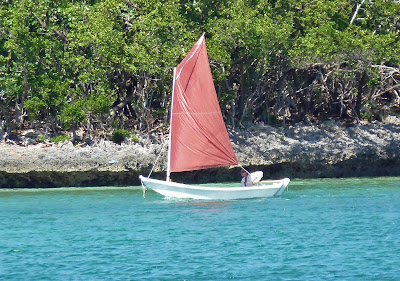
One of the water toys is a gaff-rigged Abaco sailing dinghy. It provided great fun sailing through the harbor. Once, boats of this size were used to travel through the island chain. This red-sailed boat is similar to one described in the historical fiction Wind from the Carolinas, describing the Bahamas at the time of the Loyalist arrival.

Hope Town, on Elbow Cay, is home to the famous, red-striped lighthouse. Rather than repeat that old landmark, a newly renovated Hope Town Marina is pictured at right. The open-air bar with an in-pool serving station is a grand place to spend some time with friends. It is quite a step up from the previous marina.
The woodwork and craftsmanship is alone worth a visit. An amazing hammered copper art mobile hangs in the tower portion of the building.
While on a mooring at Hope Town Marina, a large waterspout ran along the edge of Elbow Cay. Some aspects of bad weather can be entertaining, as long as they stay at a distance.
Architecture is one of the interesting aspects of strolls through Hope Town. It remains one of the more appealing of the inhabited islands.
Man-O-War Cay is known for boat building. The Albury Brothers skiffs are favorites of those fishing Bahamian waters. The graceful, wooden Abaco sailing skiffs are still being built on Man-O-War.
Another of the famous Man-O-War residents is baker Lola. She is often along the harbor in her golf cart selling her baked goods, particularly her wonderful coconut bread. She was not on the wharf, so the crew found her home, which doubles as her bakery.
An added bonus of finding Lola's home was meeting her husband who makes conch fritter dough for sale. Many a meal was enhanced aboard Last Dance with fresh conch fritters. French toast made with Lola's coconut bread is amazingly delicious.
Great Guana Cay is famous for the bar/restaurant Nippers, and infamous for the upscale Baker's Bay resort and golf course being built on the west end of the island - one example of the old charm of the Abacos being rapidly changed by big money. Good anchorages and natural beauty remain as a sunset from the anchorage in Fisher's Bay attests.
New Plymouth on Green Turtle Cay has a sculpture garden memorializing the Loyalist who fled the new United States after the Revolution. Being loyal to England and King George, they settled in the British colony of the Bahamas, among the Abaco Islands.

New Plymouth and Key West are sister cities and their sculpture gardens are related through the artist creating the sculptures. The Loyalist garden is laid out on a large Union Jack of the British flag.

The names of those honored are familiar since the current residents are all related to the few Loyalists who established their new home in the Bahama Islands.
The populated islands have a government dock where shallow-draft freight ships dock to unload cargo. Everything on the island arrives on the freighter, from food to golf carts. On a day when the freighter was not at the dock, Last Dance anchored in the bay.
The main government revenue in the Bahamas is an import tax. So, the taxman sets up his office at the dock when the freighter lands, keeping track of all items coming off the boat and being loaded. The Bahamians mostly attend college in the United States, so sports allegiances are familiar. Our taxman is a Gamecock fan.
The Green Turtle Library, which is a great resource for cruisers, is located in an old house. The original kitchen has been kept intact, giving a view of life and architecture in the Bahamas.
The Bahamas are colorful. All of the Government buildings in New Plymouth are painted pink, even the old jail.

Color also abound in the tropical flowers growing throughout the islands.


Manjack Cay is the next major island to the west. There are only three houses on the island and the largest landowner is most cruiser friendly. The beach next to his house is open to all to use, along with an assortment of water toys and an in-water tiki hut.

One of the water toys is a gaff-rigged Abaco sailing dinghy. It provided great fun sailing through the harbor. Once, boats of this size were used to travel through the island chain. This red-sailed boat is similar to one described in the historical fiction Wind from the Carolinas, describing the Bahamas at the time of the Loyalist arrival.
 |
| Sunset at Manjack |
Sunday, June 3, 2012
Loop Completion - Part Two
Arrival at Little Harbor, Abaco, completed another crossing of Last Dance's wake and completion of the Great Loop. The title photo in the blog was taken at Little Harbor on July 14, 2007. The purple line denotes the cruise from Little Harbor to St. Augustine that year -- the red follows the trip in 2011 and 2012 -- a journey just shy of 5 years.
The full moon rising over Pete's Pub in Little Harbor provided a unique venue for the completion celebration. Abaco's most famous resident, Pete Johnson, sculptor and bar proprietor, joined the crew for the unveiling of the gold burgee. Pete's fortified tropical drink, the Blaster, helped create a jovial atmosphere.
Pete suggested a poise for the occasion since the trio were all attired in Pete's Pub and Gallery shirts.
Central Bahamas
The side trip from the Great Loop to the Central Bahama Islands was planned to continue south past Great Exuma Island and across the Tropic of Cancer. Instead of the normal blue skies associated with the islands in the spring of the year, the crew experienced high winds, rough seas, gray skies, and rain. With the need to return home sooner, the journey was cut short. The voyage accomplished included stops at Bimini, Andros, past Nassau, a number of Exuma Cays and Eleuthera.
A look at the location of the Bahama Islands may be helpful to understand this voyage. This island country is east of South Florida and north of Cuba. From the Florida Keys, a trip to Cuba would have been a similar distance. A number of areas of deep water (as much as 15,000 feet) have to be transited.
Bimini
The bright blue waters of Bimini greeted Last Dance after a crossing of the Gulf Stream from Key Largo. After a long day on rolling seas, the sight of land is always welcomed.
Bimini is located closer to Ft. Lauderdale, Florida than it is to any of the other major Bahama islands. Its location has made it a major entry point to the country and, with deep, fish-filled waters within sight of shore, it draws many U.S. based fishing tournaments.

The color and quaintness of the Bahamian communities are quickly visible in Bimini. The Dolphin House has a museum on the first floor and rental apartments on the second. The outside of the building is covered in tile and stone.
The small Methodist church displays interesting architecture. Were the flying buttresses part of the original design or a shoring up after a storm?
Bimini consists of two islands: South Bimini and North Bimini. While North Bimini has the most population and is the seat of government, South Bimini had the old military runway and, thus the airport. Not to be outdone, North Bimini also has an airport, pictured at left. Seaplanes land in the harbor alongside of the marinas and taxi onto this beach -- negates the need to take the ferry between the islands.
Many larger boats cruise the central Bahamas. AlumimericA is a 123'8" yacht, built in Holland, having traveled around Cape Horn and cruised the Alaskan coast. As with many larger boats, it is available for charter (you shouldn't miss the opportunity). With that name, you would correctly guess that it is constructed of aluminum.
Anchoring on the Banks
With customs and a Bahamian telephone purchase delaying departure from Bimini, no island could be reached before sunset. A new experience of anchoring in the middle of the Bahama Banks, out of sight of any object, other than the setting sun, was a new experience for the crew.
Andros
Andros is the largest and probably the least visited of all the Bahama islands. A trip from the anchorage on the Banks to the small town of Fresh Creek, on the eastern shore, was planned to provide a starting point for a crossing of the deep Tongue of The Ocean. But, as seems the norm for this trip, plans were changed by the weather. A large storm developed, making the already uncomfortable waters of the Tongue unpleasant. Fortunately, the northern end of Andros has a harbor, Murphys Bluff, that provided a protected anchorage. An unknown benefit was experienced here. The only business in Murphys Bluff is Willie's Bar. If you stop in and buy a drink, Willie will give you the password to his WiFi, which has a strong signal reaching the harbor. This WiFi was less expensive than most connections in the islands and included an extra benefit.
The harbor was also host to many boats abandoned by their owners. Options abound for those interested in a project boat with no initial investment.
Numerous sea urchins were in the shallow waters of the harbor. They camouflage themselves by picking up shells and holding them on their backs. This poor guy found a plastic fork and is carrying it around. An example of how plastic is causing damage to the islands.
Exumas
The Exuma Land and Sea Park is a 176 square mile area including many islands and an 8 mile wide area of water along the island chain. Some of the islands in the park are park owned, others private, including one owned by Johnnie Depp. It is a no-take zone, with no fishing, lobstering, or shelling. This provides for an environment rich in sea life. Just to the right of the park office (above) is a reef full of coral, wide variety of fish, and huge lobsters.
The Park headquarters is on Warderick Wells Cay, which has many natural attractions.
The eastern shore of Warderick Wells borders the deep waters of Exuma Sound with tall bluffs of ironstone worn by continually crashing waves.
The western shore borders the shallow Bahama Banks and has a harbor protected by a chain of smaller islands. There is a narrow creek-like deep waterway cut along the island by the tidal currents. The Park has installed moorings along this area creating secure, protected places to stop.
Emerald Rock lies on the west side of Warderick Wells and has some interesting reefs around it.
There are beaches behind Emerald Rock with hiking trails across the island. One of the trails at this point leads past the ruins of a settlement of Loyalists who moved to the Bahamas in the late 1700's, after the American Revolution.
One trail leads across the island to the highest point, BooBoo Hill. The hike provides a slice of the different terrain and variety of fauna on the island.
BooBoo Hill not only provides amazing views of the islands and waters, it is a place where cruisers document their arrival at the island with names of boats inscribed on pieces of driftwood.
Amazing places are reached by cruising through the Exuma Cays. Cruising also brings one in contact with many interesting people. At the weekly happy hour at the Park, cruisers mingled and also got to know some of the Bahama Defense Force members stationed here.
The Park has moorings at other islands within the park boundaries, including Cambridge Cay above. On the east side of the island, a large rock stands just offshore. Its name is derived from its shape - Bell Rock.
Each island has local flora and fauna, often different from island to island.

Low tide reveals the Bahamian snails among the rocks.
The Exumas are known for their clear waters. Here, Pearl seems to float in the air behind Last Dance.
Much of the beauty of the Exumas lies under the water. A purchase of an underwater camera was considered for this part of the journey, but one was never obtained. Fortunately, Robin Roberts has such equipment and shared some images she captured.
Coral formations at the Aquarium Reef near Cambridge.
Queen Angel
Sargent Majors
Christmas Tree Worms on Brain Coral
A Lion Fish swims at Emerald Rock. The invasive species was introduced to waters in Florida and the Bahamas by pet owners who, when tired of the care required, dumped their aquariums into the sea. The Lion Fish has poisonous tips on their feather-like fins and have no natural enemies in these waters. Another of man's negative interactions with the environment.
An amazing sunset on the second visit to Warderick Wells. What made this sunset so notable was that this short glimpse of the fiery orb was its only appearance in three days.
Spanish Wells, Eleuthera
Spanish Wells is an island at the northern end of Eleuthera. It is a Bahamian settlement with an economy based on fishing. The crawfish boats are all in great condition, many appear like new. There are no hotels, resorts or bars on the island.
Spanish Wells does have the colorful, tropical-landscaped homes of the Bahamas.
Even the Spanish Wells All Ages School is painted colorfully.
There are only two main roads on the island. The one along the bay side of the island crosses the marine railway at the repair yard. A section of road has to be removed to move boats from the water to the work area. But, with the laid-back pace of the Bahamians, no one probably notices when the road is closed.
 The side streets connecting the two parallel roads were designed when transportation methods were by walking or animal. Today, golf carts are the main mode of transportation on the island.
The side streets connecting the two parallel roads were designed when transportation methods were by walking or animal. Today, golf carts are the main mode of transportation on the island.The road on the other side of the island is located a bit off the northern shoreline, which gives great views to buildings located there. The Methodist Church sits right on the ocean.
To the north of Spanish Wells lies the deep and wide Northeast Providence Channel, a body of water that must be crossed to reach the Abaco Islands. This makes Spanish Wells a good place to wait for settled weather, which was not to be on the day of this photo.
Subscribe to:
Posts (Atom)

